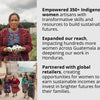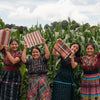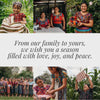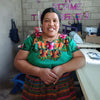Women’s Health Education: A Right, Not a Privilege
- by Caroline Boschetto

For Maya Guatemalan women living in the highlands of Santa Cruz La Laguna, education on reproductive health and rights can be an invaluable, yet difficult to access, resource.
A steep hike up the shores of Guatemala’s Lake Atitlan, about a dozen women from Mercado Global’s Grupo Cruceñas cooperative congregated on plastic stools in the cooperative’s President Cristina Hernandez de Sajquiy’s clay yard, where chickens and dogs roamed freely. This marked the first training on reproductive rights offered to the women of Grupo Cruceñas.
Accompanied by Aurora Mátzar López, Mercado Global’s Community-Based Education Training Coordinator, Senayda Mendoza led the training. Mendoza is an instructor from WINGS or ALAS, a Guatemala-based NGO that provides sexual and reproductive healthcare support to rural women that Mercado Global is partnering with this year..

Senayda began the program by taping a poster citing articles from Guatemala’s constitution on a corrugated sheet metal wall.Senayda then proceeded to inform the women present – many of whom were rocking children on their laps and breastfeeding – of the reproductive rights and resources that the Guatemalan law affords them.
According to WINGS, Guatemalan women report on average that their ideal number of children would be 2; however, the average number of children the indigenous women give birth to is 3.7. Additionally, WINGS has reported that 1 in 3 indigenous women have no access to health and family planning services.
In a fluid blend of Spanish and Kaqchikel, an indigenous Maya language spoken in the highlands of Guatemala, Senayda informed the women of their right to choose the number and timing of their pregnancies. She also led a conversation about forms of contraception that can help them make these decisions and how to access family planning resources.

Elena Chiyal Tepaz, a Grupo Cruceñas artisan and the mother of one, shared that she does not wish to have any more children due to financial constraints. Because of this, she said that she found the training on sexual and reproductive rights particularly empowering, as it afforded her the information on how to make this choice.
The reactions of the women to this new material varied from giggles and jokes to quizzical looks and downcast stares. Some women responded readily to Mendoza’s questions and others were wary to answer. Judging by their attentive listening, the women saw the value of the information given and took it to heart. The decision to use or not use the education they received will be up to these women, but either way, the opportunity to make that choice is theirs, and that is powerful.





